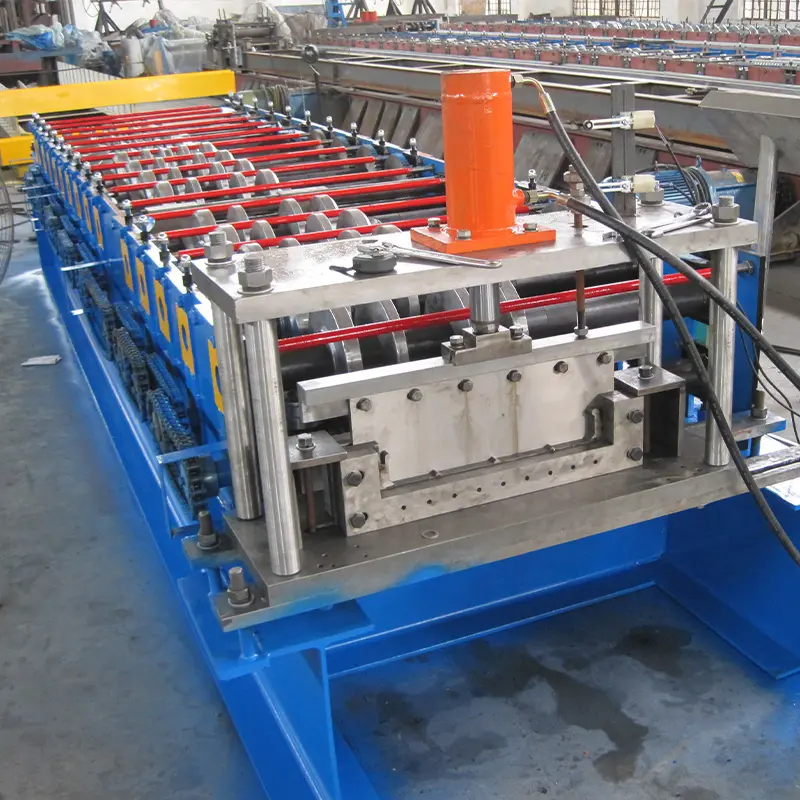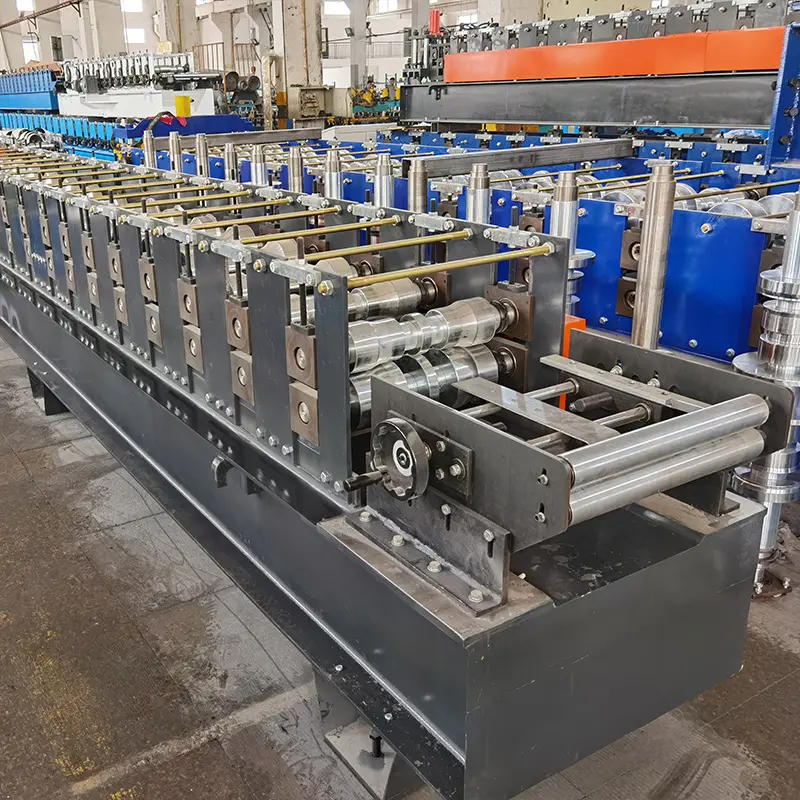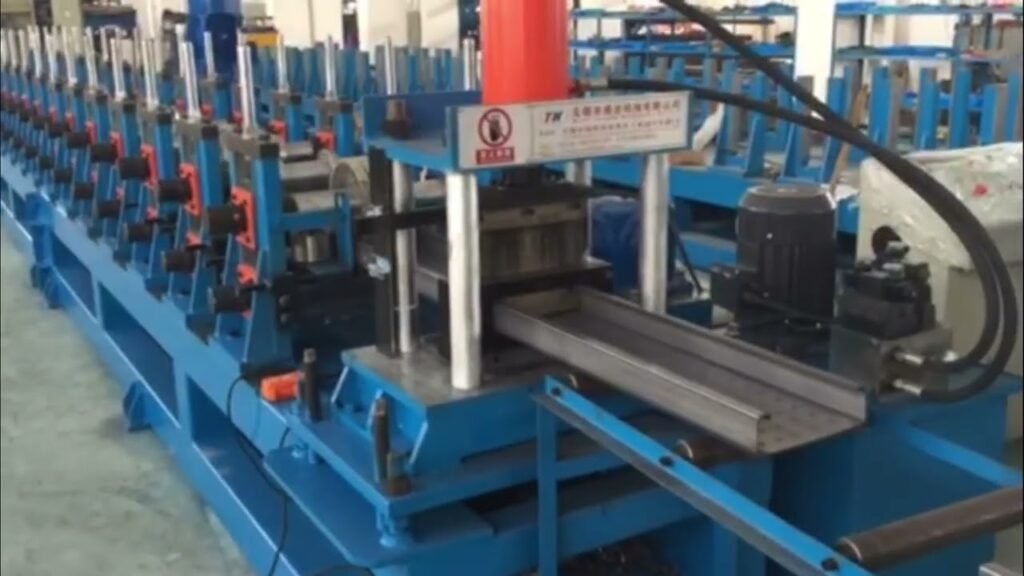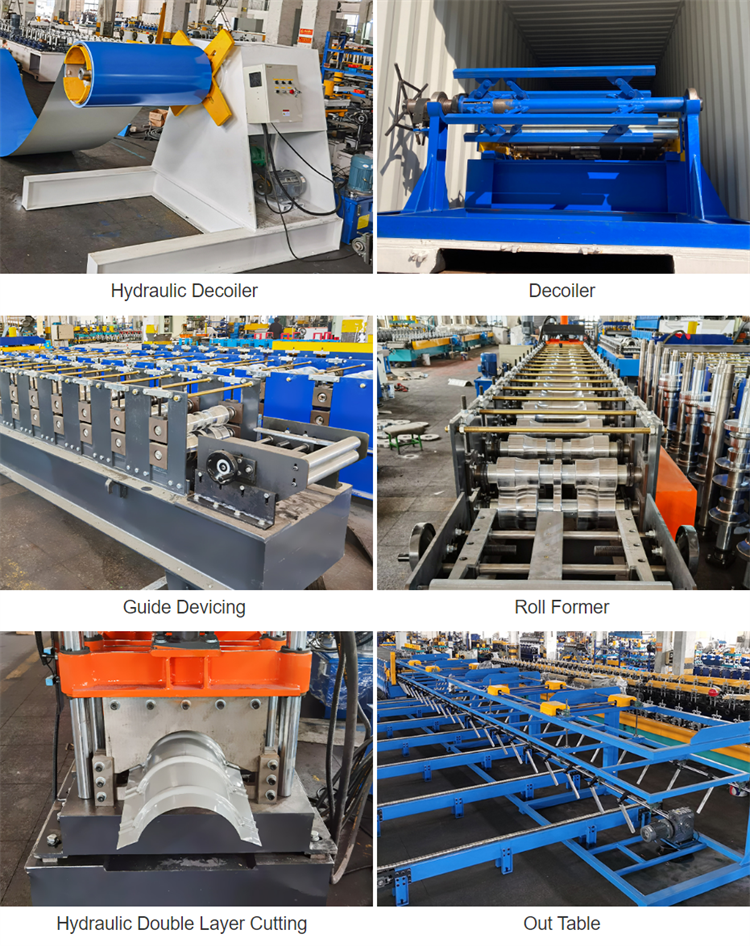परिचय
理解辊压成型机的重要性
辊压成型机在制造业中发挥关键作用,实现各种金属型材与部件的高效生产。其中一种创新设备便是 双层辊压成型机,它提供了更高的生产力和多功能性。本文将深入探讨双层辊压成型机的细节,包括其工作原理、优势、应用、维护提示、故障排除以及未来趋势。
什么是双层辊压成型机?
双层辊压成型机是一种专用设备,用于将连续金属卷材精确一致地塑形为所需型材。它由两个独立辊压成型站垂直堆叠而成,可同时生产两种不同型材或面板配置。这种独特设计提升了生产效率与灵活性,使其适用于多样化制造应用。

双层辊压成型机的工作原理
双层辊压成型机基于金属卷材连续弯曲与塑形的原理运行。以下是其工作过程的分步分解:
- 卷材展开:过程从展开金属卷材开始,该卷材装入机器入口段。
- 材料进给:金属带料随后送入第一辊压成型站,一系列辊轮模具逐步将带料塑形为所需型材。
- 第一层辊压成型:第一辊压成型站利用一组辊轮与成型模具逐步弯曲金属带料至所需形状。辊轮间隙与成型速度的精确调整确保准确一致的结果。
- 第二层辊压成型:带料通过第一站后,移至位于其上方的第二辊压成型站。第二站独立运行,可将带料塑形为不同型材或面板配置。
- 切割与堆垛:两层完成辊压成型后,机器使用剪切机构将型材切割至所需长度。切割后的型材随后堆垛或收集,用于进一步加工或组装。
使用双层辊压成型机的优势
使用双层辊压成型机为制造商带来多项优势:
- 提升生产力:两个辊压成型站的同时运行,使生产速度高于单层机器,从而缩短制造时间并提升整体生产力。
- 多功能性:双层辊压成型机可同时生产两种不同型材或面板配置。制造商可快速切换产品,满足多样化客户需求。
- 成本效益:双层辊压成型机的效率与速度有助于生产成本节省。更快的周转时间、减少材料浪费与提升输出质量均带来更高的盈利能力。
- 设计灵活性:机器的独立层设计允许制造商创建独特型材或在单一产品中融入多重功能,从而促进设计灵活性与创新。
- 改善质量与精度:双层辊压成型机对辊压过程提供精确控制,确保所有生产型材的质量一致。先进的控制系统实现精确尺寸控制与高重复性。

双层辊压成型机的应用领域
双层辊压成型机应用于多个行业:
- 建筑与建筑学:用于制造金属屋面板、墙面包覆、钢框架构件及其他建筑元素。
- 汽车行业:生产汽车车身部件,如门框、车顶横梁与结构构件。
- 暖通空调系统:制造风管、通风部件与空调系统零件。
- 家具与货架:创建金属家具部件、货架系统与存储架。
- 太阳能:生产太阳能面板框架与安装结构。
- 电气外壳:制造电气柜、控制面板与外壳系统。
- 其他行业:额外应用包括车库门、家电部件、农业设备等。
选购双层辊压成型机时需考虑的因素
为制造需求选购双层辊压成型机时,请考虑以下因素:
- 型材需求:确定所需生产的具体型材,并确保机器能适应。考虑机器可处理的的最大宽度、厚度与型材复杂度。
- 材料兼容性:检查机器是否支持您使用的材料类型,如钢材、铝材或其他金属。验证材料厚度范围及其与辊压过程的兼容性。
- 生产能力:评估所需生产量,选择满足产能需求的机器。考虑辊压速度、卷材装载能力与堆垛选项等因素。
- 机器灵活性:评估机器生产各种型材与配置的能力。寻找快速模具更换、可调辊轮间隙与独立层控制等功能。
- 自动化与控制系统:考虑机器提供的自动化与控制水平。触摸屏界面、PLC控制与集成安全系统等高级功能可提升效率与操作便利性。
- 维护与支持:确保制造商提供可靠的售后服务、技术支持与维护文档。检查保修范围与备件可用性。

双层辊压成型机的维护与安全提示
适当维护与安全实践对双层辊压成型机的最佳性能与耐用性至关重要。以下是几项关键提示:
- 定期检查:进行常规检查,识别机器部件的磨损、损坏或错位迹象。检查松动连接、润滑水平以及皮带、齿轮与轴承状况。
- 润滑:遵循制造商的润滑时间表,使用推荐润滑剂。定期润滑运动部件、辊轮与齿轮,以减少摩擦并防止过早磨损。
- 清洁:保持机器清洁,无碎屑、灰尘与金属屑。采用适当清洁方法,避免可能损坏机器表面的磨蚀材料。
- 安全措施:实施全面安全措施,包括为操作员提供个人防护装备(PPE)。确保紧急停止按钮、安全护栏与联锁系统就位且正常运行。
- 操作员培训:为机器操作员提供全面培训,确保他们理解设备操作、安全协议与维护程序。定期更新培训计划,以涵盖新功能或技术。
- 文档记录:详细记录维护活动、检查、维修与机器修改。这份文档有助于故障排除与未来参考。
双层辊压成型机常见问题故障排除
即使定期维护,双层辊压成型机也可能偶发问题。以下是常见问题及其可能解决方案:
- 型材尺寸不均:检查辊轮错位、成型模具损坏或辊轮间隙调整不当。确保所有部件按所需型材规格正确对齐与调整。
- 材料卡住:若金属带料在辊压过程中卡住或堵塞,检查入口与出口导轨是否有障碍物。清除任何阻碍材料顺畅移动的碎屑或异物。
- 型材形状不一致:验证材料厚度是否在机器指定范围内。不准确塑形也可能因磨损或损坏的成型辊轮引起。更换磨损部件并确保正确对齐,以实现一致型材形状。
- 过度噪音或振动:运行中过度噪音或振动可能表示辊轮错位、部件松动或轴承损坏。对机器机械部件进行彻底检查并紧固松动连接。更换磨损轴承或其他损坏部件。
- 卷材对齐问题:卷材对齐不当可能导致进料问题并影响成型型材质量。检查卷材装载系统的对齐与张力控制。调整导轨,确保进料过程中材料正确居中与对齐。
- 电气或控制故障:若机器出现电气或控制问题,检查布线、连接与控制系统。检查松动连接、损坏电缆或故障传感器。参考机器手册或联系制造商协助诊断与解决电气问题。
- 润滑不足:润滑不当会导致摩擦增加、过早磨损与性能不佳。遵循制造商推荐的润滑时间表,并为机器各部件使用适当润滑剂。定期检查并补充润滑油箱。
若故障排除困难或需专业知识,建议联系机器制造商或寻求专业技术人员协助。

双层辊压成型技术的未来趋势
双层辊压成型技术持续演进,融入创新功能与进步。以下是几项值得关注的未来趋势:
- 集成自动化:自动化在提升效率与减少人为错误方面发挥重要作用。未来双层辊压成型机预计将集成先进自动化技术,如机器人材料处理、自动模具更换与实时生产监控。
- 增强控制系统:高级控制系统将提供改进的用户界面、直观编程与数据分析能力。这些功能将帮助制造商优化生产、监控性能并做出数据驱动决策。
- 轻质材料应用:随着各行业对轻质材料需求的增长,双层辊压成型机将适应加工先进高强度钢、铝合金与复合材料,以满足减重与提升燃油效率的需求。
- 定制化与设计灵活性:制造商将受益于更高的设计灵活性与定制选项。未来机器可能融入模块化模具系统与高级软件,实现快速产品切换与快速原型制作。
- 能效优化:对可持续性与能效的关注将推动更节能双层辊压成型机的开发。优化的电机系统、能量回收机制与智能电源管理将降低运行能耗。
- 在线质量检测集成:在线质量检测系统将集成至双层辊压成型机,实现实时质量控制与缺陷检测。视觉系统、传感器与机器学习算法将确保一致的高品质生产。

निष्कर्ष
双
常见问题解答
1. 单层辊压成型机与双层辊压成型机的区别是什么? 单层辊压成型机仅有一个辊压成型站,而双层辊压成型机拥有两个垂直堆叠的独立成型站。双层设计可同时生产两种不同型材或面板配置,从而显著提升生产效率与灵活性。
2. 双层辊压成型机能否处理不同类型的金属? 是的,双层辊压成型机可加工钢、铝等多种金属。但需仔细查阅机器规格,确保其与所需型材的具体金属类型及厚度相兼容。
3. 双层辊压成型机适合小规模生产吗? 双层辊压成型机广泛应用于小规模及大规模生产环境。其多功能性、设计灵活性和快速产品切换能力,使其适用于各种制造需求。
4. 双层辊压成型机应多久维护一次? 定期维护对确保双层辊压成型机的最佳性能与使用寿命至关重要。维护频率取决于机器使用情况、运行条件及制造商建议。建议遵循制造商维护计划,并进行常规检查以及时发现并解决问题。
5. 双层辊压成型机能否根据特定生产需求定制? 是的,双层辊压成型机可根据特定生产需求进行定制。制造商通常提供模块化工具系统、可调辊间隙及可编程控制系统等选项,从而灵活创建独特型材或满足特定客户需求。建议与机器制造商咨询定制方案。
Frequently Asked Questions (FAQ)
1) Can a double deck roll forming machine run two different coil materials at the same time?
- Yes, if each deck has independent drive, guides, and decoilers. To avoid marking and camber mismatch, keep gauge and yield strength similar per deck or use separate straighteners.
2) What is the typical changeover time between profiles on a double deck line?
- With cassette tooling and recipe-driven setups: 20–45 minutes per deck. Without quick-change features, expect 60–120 minutes due to roll gap, lateral guide, and shear adjustments.
3) How do I minimize cross-talk vibration between the upper and lower decks?
- Specify isolated frames or damped sub-frames, use servo synchronization, balance rolls, and add tuned mass dampers on long bases. Maintain foundation flatness within ±0.5 mm/m.
4) What tolerances are realistic for roofing and cladding profiles at 12–25 m/min?
- For 0.4–0.8 mm coated steel: length ±1.0 mm/m, panel width ±0.5 mm, rib height ±0.5 mm, squareness ≤0.5°. Achieving tighter tolerances requires inline laser measurement and temperature compensation.
5) Is inline punching feasible on both decks simultaneously?
- Yes, with independent hydraulic or servo-hydraulic punch units and a synchronized flying shear. Ensure adequate accumulator capacity and verify that press tonnage matches the thickest deck’s hole pattern.
2025 Industry Trends
- AI-enabled inline QC: Mid-market Double Deck Roll Forming Machines increasingly ship with affordable vision + laser triangulation to detect burrs, oil canning, hole offset, and panel width drift.
- Energy optimization: Regenerative servo drives and high-efficiency gearmotors cut energy per meter 15–25% versus 2021-era lines.
- Quick-change maturity: Cassette/raft tooling adoption expands, reducing downtime and enabling high-mix roofing and cladding.
- Corrosion-resistant materials: Zn-Al-Mg (ZAM) and PVDF-coated coils gain share in coastal and solar projects.
- Connected factories: OPC UA/MQTT gateways link double deck lines to MES for lot traceability, SPC, and OEE dashboards.
- Safety and compliance: Wider use of ISO 13849 PL-d safety architectures and interlocked guards on export models.
| KPI for Double Deck Roll Forming Machines | 2022 Baseline | 2025 Typical Range | Impact on Users | Sources |
|---|---|---|---|---|
| Adoption of inline vision/laser QC on new lines | ~10–15% | 35–50% | Scrap -20–45%, faster first-article approval | FMA 2024–2025; SME reports |
| Average changeover time (with cassettes) | 45–90 min | 20–45 min | +8–15% OEE on high-mix plants | FMA Roll Forming Council |
| Energy use (kWh per meter, 0.5–0.8 mm coil) | 0.26–0.34 | 0.20–0.27 | 15–25% energy savings | DOE AMO briefs; OEM datasheets |
| Share of ZAM/PVDF-coated coils in roofing/cladding | ~7–10% | 15–25% | Longer service life; fewer warranty claims | ISO 12944 refs; coil makers |
| Lines with OPC UA/MES connectivity | ~18–22% | 45–60% | Better traceability and PPAP compliance | OPC Foundation; NIST SMS |
Authoritative references:
- Fabricators & Manufacturers Association (FMA): https://www.fmamfg.org
- SME Smart Manufacturing: https://www.sme.org
- U.S. DOE Advanced Manufacturing Office: https://www.energy.gov/eere/amo
- OPC Foundation: https://opcfoundation.org
- ISO 12944 Corrosion Protection (overview): https://www.iso.org
Latest Research Cases
Case Study 1: High-Mix Roofing on Double Deck With Cassette Tooling (2025)
Background: A Southeast Asia roofing producer needed to run five panel styles daily with small batches while maintaining throughput.
Solution: Upgraded to double deck with cassette tooling, barcode-recipe integration, and laser width measurement on both decks. Added regenerative servo drives.
Results: Changeover time cut from 72 to 31 minutes; scrap reduced from 2.1% to 0.8%; energy/meter -18%; OEE improved by 11%. Supported faster PPAP for export projects.
Case Study 2: Inline Vision to Control Oil Canning on Prepainted Coils (2024)
Background: A Middle East façade fabricator saw visible waviness on PVDF panels at summer temperatures.
Solution: Installed thermal-compensated roll gap control and AI vision detecting surface waviness; feedback adjusted side-roll pressure and entry tension live.
Results: Customer claims down 64%; panel flatness Cp improved from 1.08 to 1.45; rework -40%. Enabled premium pricing on façade jobs.
Expert Opinions
- Dr. Taylan Altan, Founder, Center for Precision Forming (Ohio State University)
Key viewpoint: Use FE simulation and incremental pass design to manage springback and edge wave, especially on AHSS and ZAM. Larger roll diameters and additional passes stabilize profiles on upper decks. - Cynthia Kustush, Senior Editor, The Fabricator (FMA Media)
Key viewpoint: Plants standardizing quick-change (color-coded cassettes, digital torque specs, barcode-driven recipes) achieve the fastest ROI on double deck roll forming machine upgrades. - Andrew Zaske, VP, Applus Laboratories North America
Key viewpoint: Feed coil lot mechanicals (yield, tensile, elongation, coating hardness) into the HMI recipe. Lot variability is the top driver of dimensional drift and burrs at higher line speeds.
Sources: Center for Precision Forming publications; The Fabricator features; Applus technical briefs.
Practical Tools/Resources
- COPRA RF (data M): Pass design, FE analysis, springback compensation. https://www.datam.de/en/products/copra-rollforming
- UBECO PROFIL: Flower pattern design for dual profiles and quick export to CNC. https://www.ubeco.com
- Keyence/Cognex: Vision and laser displacement for inline panel width, hole position, and surface defects. https://www.keyence.com https://www.cognex.com
- OPC UA SDKs and companion specs for machine connectivity. https://opcfoundation.org
- NIST Smart Manufacturing resources (MES, cybersecurity). https://www.nist.gov
- ISO safety standards to reference in specs: ISO 12100, ISO 14120, ISO 13849
SEO tip: Use semantic variations such as “double deck roll forming line,” “dual-level roll former,” and “two-profile roll forming machine” in headings and image alt text to reinforce topical relevance.
Last updated: 2025-10-20
Changelog: Added 5 new FAQs, 2025 trend table with KPIs and sources, two recent case studies, expert insights, and practical tools/resources with authoritative links for Double Deck Roll Forming Machines
Next review date & triggers: 2026-04-15 or earlier if major OEMs release new quick-change/AI QC modules, ISO/DOE guidance updates, or OPC UA companion specs for roll forming are published
